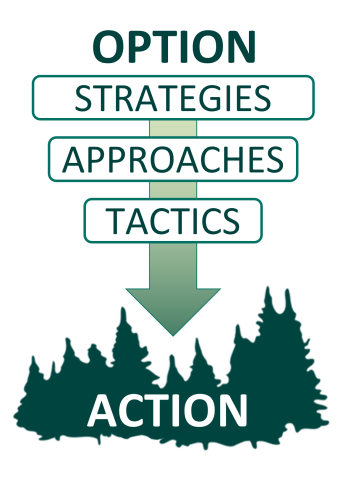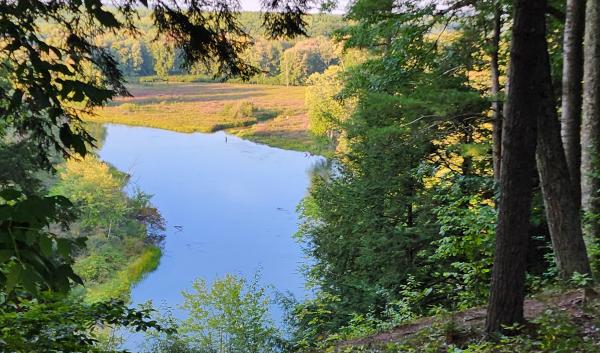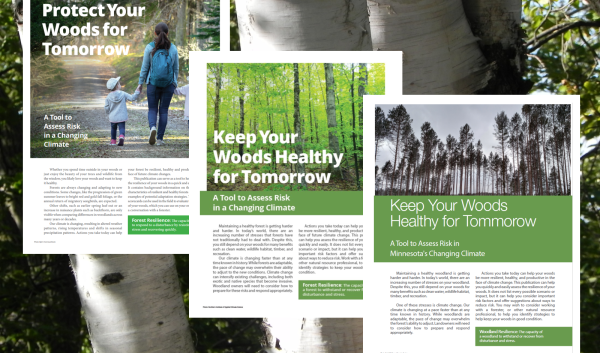Climate change is a significant threat for wildlife around the world.
The real‐world application of climate change adaptation practices in terrestrial wildlife conservation has been slowed by a lack of practical guidance for wildlife managers. Although there is a rapidly growing body of literature on the topic of climate change adaptation and wildlife management, the literature is weighted towards a narrow range of adaptation actions and administrative or policy recommendations that are typically beyond the decision space and influence of wildlife professionals. We developed a menu of tiered adaptation actions for terrestrial wildlife management to translate broad concepts into actionable approaches to help managers respond to climate change risks and meet desired management goals. The menu includes actions related to managing wildlife populations as well as managing wildlife habitat.
Effects from Climate Change
The magnitude of projected change by the end of the century will present serious and multifaceted challenges for biodiversity, particularly for species that specialize on vulnerable habitats or a narrow range of conditions. The rapid on‐going and projected changes in climate will likely exceed the adaptive capacity of many wildlife species. The ecological impacts of modern climate change will be widespread but not uniform, as individual organisms and populations vary in exposure, sensitivity, and adaptive capacity. Even species that are not directly threatened by changes in seasonality, phenology, or extreme events may be affected as climate change indirectly affects habitat quality, exacerbates existing stressors, and leads to novel interactions.

Adaptation in Action
Given the severity and pervasiveness of climate change impacts on wildlife, conventional paradigms of wildlife management may no longer be adequate to achieve conservation goals. For example, habitat restoration and habitat protection might not ensure the long‐term persistence of a species if the climate across the species' range shifts beyond physiological thresholds. In this context, adaptation refers to the intentional, planned adjustments to natural and human systems to reduce the risks from climate change. Climate change vulnerability is conventionally expressed as a combination of the exposure, sensitivity, and adaptive capacity of a system or organism, and therefore climate change adaptation decisions often stem from the desire to minimize potential impacts or enhance adaptive capacity.
The Wildlife Adaptation Menu was created to consolidate and organize a collection of adaptation actions relevant to terrestrial wildlife management, to support the work of natural resources professionals while providing the best available climate adaptation science.
The Wildlife Adaptation Menu is designed to be used as a stand-alone resource, and it can also be used to supplement structured adaptation planning with the Adaptation Workbook process (published in Forest Adaptation Resources: Climate Change Tools and Approaches for Land Managers).

Strategies and Approaches
The 13 strategies, 80 approaches, and 100+ tactics were developed through an assessment of existing adaptation tools, focus group discussions, and workshops with natural resource professionals.
Adaptation strategies are very general and can be applied in many ways across different ecosystems and cultural contexts. Adaptation approaches are more specific, describing in greater detail how strategies could be put into practice.
These strategies and approaches are designed to serve as stepping stones to allow natural resource managers and planners to translate broad concepts into targeted and specific actions (tactics) for putting climate change adaptation into practice to achieve a specific management objective in a specific location.
Example tactics are provided in the menu as illustrations of a few of the possible actions that could implemented for climate adaptation.
Menu of Strategies and Approaches for Wildlife Management
Adaptation Strategies for Population Management
-
Approach 1.1. Increase genetic exchange between populations.
Approach 1.2. Maintain and enhance genetic admixture (interbreeding) zones in order to facilitate adaptive genetic exchange
Approach 1.3. Limit genetic exchange to protect isolated populations.
Approach 1.4. Prioritize conservation of trailing edge or leading-edge populations.
Approach 1.5. Maintain populations in disturbed environments because they may contain adaptive traits.
Approach 1.6. Protect areas of high phylogenetic or phenotypic diversity or endemism.
Approach 1.7. Translocate individuals with climate-adaptive genetic traits.
Approach 1.8. Preserve genetic material (gene banks).
Approach 1.9. Restore genetic diversity in isolated or inbred populations (genetic rescue).
-
Approach 2.1. Translocate individuals or populations to habitat within the existing range that was formerly occupied and remains suitable (reintroduction).
Approach 2.2. Identify and protect source sub-populations.
Approach 2.3. Establish and maintain connectivity between sub-populations through corridors or stepping stones.
-
Approach 3.1. Establish corridors and minimize barriers to movement to new suitable habitats.
Approach 3.2. Prepare suitable habitat in anticipation of future introduction, reintroduction, or natural range shift of a species.
Approach 3.3. Move and release individuals into a population where conditions are now suitable and are expected to improve.
Approach 3.4. Reintroduce species where climate is expected to remain suitable.
Approach 3.5. Conserve leading-edge populations (high altitude, northern, etc.).
Approach 3.6. Introduce species to new areas with suitable current and future climate.
-
Approach 4.1. Increase or protect existing biodiversity, for example species richness, functional diversity, and phylogenetic diversity.
Approach 4.2. Detect and remove non-native invasive species.
Approach 4.3. Manage predator populations.
Approach 4.4. Restore historic trophic linkages.
Approach 4.5. Maintain functional groups or keystone species that help sustain ecosystem functions.
Approach 4.6. Reintroduce extirpated species or functional groups.
Approach 4.7. Manage extant and emerging diseases.
-
Approach 5.1. Move and attract individuals to augment an existing population.
Approach 5.2. Increase reproduction and survival rates.
Approach 5.3. Use captive breeding programs to increase populations of declining or rare species.
Approach 5.4. Manage natural predation to increase populations of declining or rare species.
Approach 5.5. Control take, harvest, and illegal harvest.
-
Approach 6.1: Adjust harvest regulations to increase population size for declining species or species anticipated to be impacted by climate change.
Approach 6.2. Adjust harvest regulations to decrease population size.
Approach 6.3. Adjust harvest regulations to facilitate shifting phenology or species ranges.
-
Approach 7.1 Anticipate and manage conflict from increasing populations, range expansions, or changing behaviors.
7.2. Manage conflict associated with societal adaptations to climate change. 7.3. Reduce or limit access to sensitive habitats or environments. 7.4. Reduce or remove human disturbance stress during sensitive time periods. 7.5. Implement nonlethal behavioral control methods (barriers and deterrents).
Adaptation Strategies for Habitat Management
-
Approach 8.1. Manage for plant species diversity and complexity.
Approach 8.2. Promote plant genetic diversity.
Approach 8.3. Prioritize native vegetation and suitable site conditions for habitat management and restoration.
Approach 8.4. Manage and create suitable microhabitats and microclimates.
Approach 8.5. Enhance primary food sources for specialist climate-sensitive species.
Approach 8.6. Provide supplemental food sources.
Approach 8.7. Create or maintain sources of food, water, and cover in a variety of locations across the landscape.
Approach 8.8. Maintain or mimic natural disturbance regimes to enhance habitat quality.
-
Approach 9.1. Use non-local, future-adapted genotypes in habitat management.
Approach 9.2. Create new sources of food, water, and cover in anticipation of future conditions.
Approach 9.3. Accommodate altered hydrology, accounting for periods of high water and low water availability.
Approach 9.4. Maintain or enhance sources of food, water, and cover across the annual cycle and different life stages in response to changing phenology.
Approach 9.5. Establish or redesign infrastructure to protect habitat from anticipated climate impacts.
-
Approach 10.1. Create large, intact, or aggregated protected areas.
Approach 10.2. Increase representation and replication of protected species and habitats across the portfolio of protected areas.
Approach 10.3. Select reserves that maximize biodiversity protection for a suite of species.
Approach 10.4. Orient suites of protected areas in ways that span gradients in climate.
Approach 10.5. Create protected areas that maximize topographic and geologic variety.
Approach 10.6. Protect areas at high risk of change due to climate or land use change.
Approach 10.7. Protect climate refugia across the landscape.
Approach 10.8. Protect sites that are expected to provide future suitable habitat.
Approach 10.9. Protect stepping stones, adjacent reserves, and corridors.
Approach 10.10. Create temporary or dynamic reserves.
Approach 10.11. Maintain or enhance habitat across the annual cycle and life stages.
Approach 10.12. Protect current safe havens for climate vulnerable populations to ensure those populations are available for future conservation efforts.
Approach 10.13. Protect sufficient habitat for viable populations to be self-sustaining and of sufficient quality to create surplus dispersers.
-
Approach 11.1. Identify and restore degraded landscapes with high potential habitat quality.
Approach 11.2. Reduce or limit barriers to wildlife movement across private land.
Approach 11.3. Manage private lands near and between protected lands (buffer zones) .
Approach 11.4. Enhance green infrastructure and promote sustainable urban landscapes.
Approach 11.5. Manage public or private agricultural land to provide compatible wildlife use.
Approach 11.6. Manage forest structure to provide compatible wildlife use.
Additional Adaptation Strategies
-
Approach 12.1. Take no action in some situations as part of an overall triage strategy.
Approach 12.2. Designate no action areas as a control to compare with management interventions.
Approach 12.3. Allow for autonomous, or unassisted, adaptation to climate change.
-
Approach 13.1. Develop outreach and technical assistance programs for the public.
Approach 13.2. Provide access for wildlife-dependent recreation.
Approach 13.3. Increase local community involvement in wildlife management.
Approach 13.4. Promote community-managed conservation lands.
Approach 13.5. Respect and incorporate landscape values of indigenous communities in management decisions.
Approach 13.6. Pay for ecosystem services that also benefit wildlife.
Approach 13.7. Coordinate across landowners and scales to make sure programs are complementary.
Citation
Handler, S. D., Ledee, O. E., Hoving, C. L., Zuckerberg, B., & Swanston, C. W. (2022). A menu of climate change adaptation actions for terrestrial wildlife management. Wildlife Society Bulletin, 46(4), e1331.https://doi.org/10.1002/wsb.1331
Acknowledgements
The Northern Institute for Applied Climate Science, Northeast CASC and regional partners led the development of the wildlife adaptation strategies and approaches, which can be used with the Adaptation Workbook process (published in Forest Adaptation Resources: Climate Change Tools and Approaches for Land Managers). The Northern Institute of Applied Climate Science (NIACS) a collaborative, multi-institutional partnership led and supported by the USDA Forest Service.



